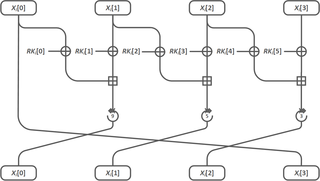Description
KASUMI algorithm is specified in a 3GPP technical specification. [6] KASUMI is a block cipher with 128-bit key and 64-bit input and output. The core of KASUMI is an eight-round Feistel network. The round functions in the main Feistel network are irreversible Feistel-like network transformations. In each round the round function uses a round key which consists of eight 16-bit sub keys derived from the original 128-bit key using a fixed key schedule.
Key schedule
The 128-bit key K is divided into eight 16-bit sub keys Ki:
Additionally a modified key K', similarly divided into 16-bit sub keys K'i, is used. The modified key is derived from the original key by XORing with 0x123456789ABCDEFFEDCBA9876543210 (chosen as a "nothing up my sleeve" number).
Round keys are either derived from the sub keys by bitwise rotation to left by a given amount and from the modified sub keys (unchanged).
The round keys are as follows:
Sub key index additions are cyclic so that if i+j is greater than 8 one has to subtract 8 from the result to get the actual sub key index.
The algorithm
KASUMI algorithm processes the 64-bit word in two 32-bit halves, left () and right (). The input word is concatenation of the left and right halves of the first round:
.
In each round the right half is XOR'ed with the output of the round function after which the halves are swapped:
where KLi, KOi, KIi are round keys for the ith round.
The round functions for even and odd rounds are slightly different. In each case the round function is a composition of two functions FLi and FOi. For an odd round
and for an even round
.
The output is the concatenation of the outputs of the last round.
.
Both FL and FO functions divide the 32-bit input data to two 16-bit halves. The FL function is an irreversible bit manipulation while the FO function is an irreversible three round Feistel-like network.
Function FL
The 32-bit input x of is divided to two 16-bit halves . First the left half of the input is ANDed bitwise with round key and rotated left by one bit. The result of that is XOR'ed to the right half of the input to get the right half of the output .
Then the right half of the output is ORed bitwise with the round key and rotated left by one bit. The result of that is XOR'ed to the left half of the input to get the left half of the output .
Output of the function is concatenation of the left and right halves .
Function FO
The 32-bit input x of is divided into two 16-bit halves , and passed through three rounds of a Feistel network.
In each of the three rounds (indexed by j that takes values 1, 2, and 3) the left half is modified to get the new right half and the right half is made the left half of the next round.
The output of the function is .
Function FI
The function FI is an irregular Feistel-like network.
The 16-bit input of the function is divided to two halves of which is 9 bits wide and is 7 bits wide.
Bits in the left half are first shuffled by 9-bit substitution box (S-box) S9 and the result is XOR'ed with the zero-extended right half to get the new 9-bit right half .
Bits of the right half are shuffled by 7-bit S-box S7 and the result is XOR'ed with the seven least significant bits (LS7) of the new right half to get the new 7-bit left half .
The intermediate word is XORed with the round key KI to get of which is 7 bits wide and is 9 bits wide.
Bits in the right half are then shuffled by 9-bit S-box S9 and the result is XOR'ed with the zero-extended left half to get the new 9-bit right half of the output .
Finally the bits of the left half are shuffled by 7-bit S-box S7 and the result is XOR'ed with the seven least significant bits (LS7) of the right half of the output to get the 7-bit left half of the output.
The output is the concatenation of the final left and right halves .
Substitution boxes
The substitution boxes (S-boxes) S7 and S9 are defined by both bit-wise AND-XOR expressions and look-up tables in the specification. The bit-wise expressions are intended to hardware implementation but nowadays it is customary to use the look-up tables even in the HW design.
S7 is defined by the following array:
intS7[128]={54,50,62,56,22,34,94,96,38,6,63,93,2,18,123,33,55,113,39,114,21,67,65,12,47,73,46,27,25,111,124,81,53,9,121,79,52,60,58,48,101,127,40,120,104,70,71,43,20,122,72,61,23,109,13,100,77,1,16,7,82,10,105,98,117,116,76,11,89,106,0,125,118,99,86,69,30,57,126,87,112,51,17,5,95,14,90,84,91,8,35,103,32,97,28,66,102,31,26,45,75,4,85,92,37,74,80,49,68,29,115,44,64,107,108,24,110,83,36,78,42,19,15,41,88,119,59,3};S9 is defined by the following array:
intS9[512]={167,239,161,379,391,334,9,338,38,226,48,358,452,385,90,397,183,253,147,331,415,340,51,362,306,500,262,82,216,159,356,177,175,241,489,37,206,17,0,333,44,254,378,58,143,220,81,400,95,3,315,245,54,235,218,405,472,264,172,494,371,290,399,76,165,197,395,121,257,480,423,212,240,28,462,176,406,507,288,223,501,407,249,265,89,186,221,428,164,74,440,196,458,421,350,163,232,158,134,354,13,250,491,142,191,69,193,425,152,227,366,135,344,300,276,242,437,320,113,278,11,243,87,317,36,93,496,27,487,446,482,41,68,156,457,131,326,403,339,20,39,115,442,124,475,384,508,53,112,170,479,151,126,169,73,268,279,321,168,364,363,292,46,499,393,327,324,24,456,267,157,460,488,426,309,229,439,506,208,271,349,401,434,236,16,209,359,52,56,120,199,277,465,416,252,287,246,6,83,305,420,345,153,502,65,61,244,282,173,222,418,67,386,368,261,101,476,291,195,430,49,79,166,330,280,383,373,128,382,408,155,495,367,388,274,107,459,417,62,454,132,225,203,316,234,14,301,91,503,286,424,211,347,307,140,374,35,103,125,427,19,214,453,146,498,314,444,230,256,329,198,285,50,116,78,410,10,205,510,171,231,45,139,467,29,86,505,32,72,26,342,150,313,490,431,238,411,325,149,473,40,119,174,355,185,233,389,71,448,273,372,55,110,178,322,12,469,392,369,190,1,109,375,137,181,88,75,308,260,484,98,272,370,275,412,111,336,318,4,504,492,259,304,77,337,435,21,357,303,332,483,18,47,85,25,497,474,289,100,269,296,478,270,106,31,104,433,84,414,486,394,96,99,154,511,148,413,361,409,255,162,215,302,201,266,351,343,144,441,365,108,298,251,34,182,509,138,210,335,133,311,352,328,141,396,346,123,319,450,281,429,228,443,481,92,404,485,422,248,297,23,213,130,466,22,217,283,70,294,360,419,127,312,377,7,468,194,2,117,295,463,258,224,447,247,187,80,398,284,353,105,390,299,471,470,184,57,200,348,63,204,188,33,451,97,30,310,219,94,160,129,493,64,179,263,102,189,207,114,402,438,477,387,122,192,42,381,5,145,118,180,449,293,323,136,380,43,66,60,455,341,445,202,432,8,237,15,376,436,464,59,461};
















































